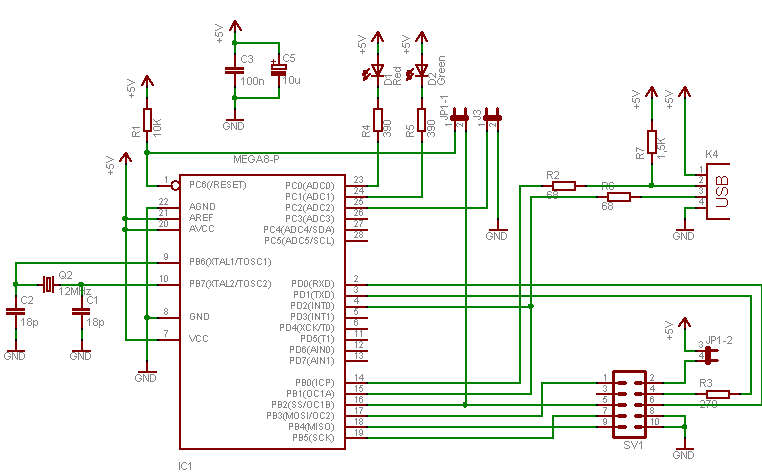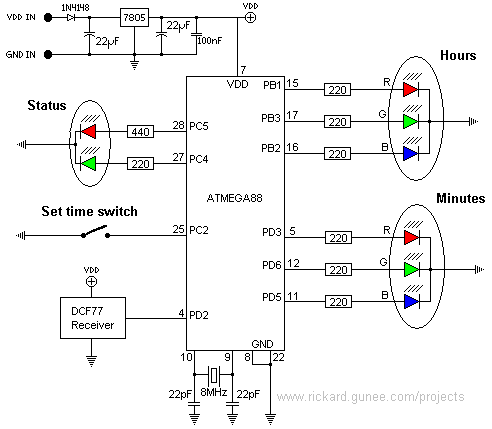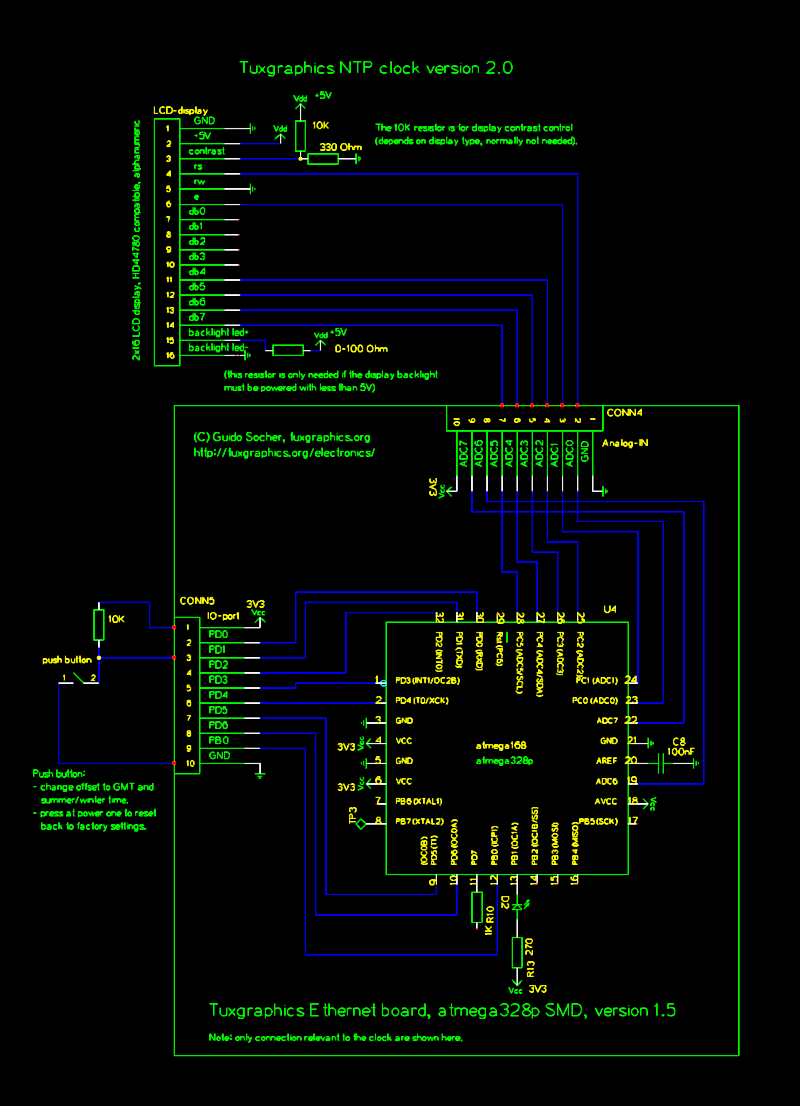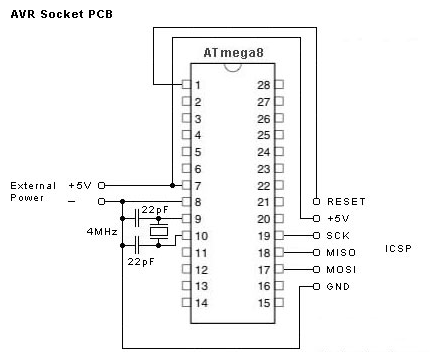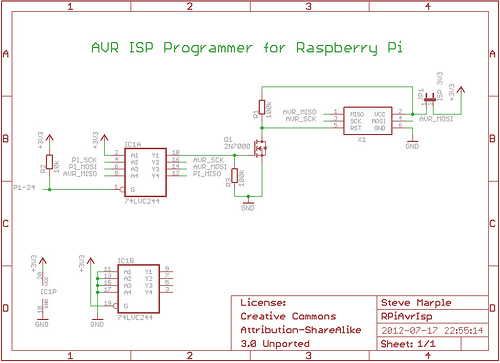
AVR Dongle

This circuit is designed to program AVR controllers such as the AT90S1200 using a parallel port. The circuit is straightforward, with IC1 serving as a buffer for the signals transmitted between the parallel port and the microcontroller. This encompasses the primary functionality of the circuit. The two box headers (K2 and K3) adhere to the standard ISP (in-system programming) pinout for AVR controllers. The manufacturer endorses these pinouts to establish a standard for in-circuit programming of AVR controllers, and these connections are commonly found on various development boards for these devices. The programming task is executed by software, necessitating the use of a program (ATMEL AVR ISP), which can be downloaded for free. The circuit should be constructed on a standard prototype board, as no PCB design has been provided. Given the limited number of components, this should not pose significant challenges. It is advisable for less experienced builders to create a copy of the circuit and mark off each connection on the schematic as it is made on the board. This practice simplifies the verification process to ensure all connections have been correctly established.
The circuit utilizes a parallel port interface to facilitate communication with the AVR microcontroller, specifically designed for programming tasks. The inclusion of IC1 as a buffer is crucial, as it ensures that the signals from the parallel port are adequately conditioned for the microcontroller's input requirements, thus preventing potential damage from signal levels that are too high or too low. The use of standard ISP pinouts (K2 and K3) aligns with industry practices, allowing for compatibility with a wide range of AVR development boards and tools. This design choice not only enhances usability but also promotes a modular approach to microcontroller programming.
The programming software, ATMEL AVR ISP, is essential for executing the programming sequence. It communicates with the microcontroller through the buffered signals, allowing for the transfer of firmware or configuration data. Users are encouraged to download this software to facilitate the programming process effectively.
For construction, the circuit is intended to be assembled on a standard prototype board. This approach allows for flexibility in layout and component placement, accommodating various configurations. The simplicity of the design, characterized by a minimal number of components, aids in reducing assembly errors. It is recommended that builders, particularly those with limited experience, follow a systematic approach by marking off connections on the schematic as they are completed. This method not only aids in ensuring accuracy but also serves as a valuable learning tool for understanding circuit assembly and troubleshooting. Overall, this circuit serves as an accessible introduction to programming AVR controllers, making it suitable for both novice and experienced users.This circuit is intended to program AVR controllers such as the AT90S1200 via the parallel port. The circuit is extremely simple. IC1 provides buffering for the signals that travel from the parallel port to the microcontroller and vice versa. This is essentially everything that can be said about the circuit. The two boxheaders (K2 and K3) have the standard` ISP (in system programming) pinout for the AVR controllers. The manufacturer recommends these two pinouts in an attempt to create a kind of standard for the in-circuit programming of AVR-controllers. These connections can be found on many development boards for these controllers. The software carries out the actual programming task. It is therefore necessary to have a program (ATMEL AVR ISP), which is available as a free download from The construction of the circuit will have to made on standard prototype board, since we didn`t design a PCB for this circuit.
This should not present any difficulties considering the small number of parts involved. We recommend that inexperienced buildersrst make a copy of the circuit and cross off each connection on the schematic once it has been made on the board. This makes it easy to check after-wards whether all connections have been made or not. 🔗 External reference
The circuit utilizes a parallel port interface to facilitate communication with the AVR microcontroller, specifically designed for programming tasks. The inclusion of IC1 as a buffer is crucial, as it ensures that the signals from the parallel port are adequately conditioned for the microcontroller's input requirements, thus preventing potential damage from signal levels that are too high or too low. The use of standard ISP pinouts (K2 and K3) aligns with industry practices, allowing for compatibility with a wide range of AVR development boards and tools. This design choice not only enhances usability but also promotes a modular approach to microcontroller programming.
The programming software, ATMEL AVR ISP, is essential for executing the programming sequence. It communicates with the microcontroller through the buffered signals, allowing for the transfer of firmware or configuration data. Users are encouraged to download this software to facilitate the programming process effectively.
For construction, the circuit is intended to be assembled on a standard prototype board. This approach allows for flexibility in layout and component placement, accommodating various configurations. The simplicity of the design, characterized by a minimal number of components, aids in reducing assembly errors. It is recommended that builders, particularly those with limited experience, follow a systematic approach by marking off connections on the schematic as they are completed. This method not only aids in ensuring accuracy but also serves as a valuable learning tool for understanding circuit assembly and troubleshooting. Overall, this circuit serves as an accessible introduction to programming AVR controllers, making it suitable for both novice and experienced users.This circuit is intended to program AVR controllers such as the AT90S1200 via the parallel port. The circuit is extremely simple. IC1 provides buffering for the signals that travel from the parallel port to the microcontroller and vice versa. This is essentially everything that can be said about the circuit. The two boxheaders (K2 and K3) have the standard` ISP (in system programming) pinout for the AVR controllers. The manufacturer recommends these two pinouts in an attempt to create a kind of standard for the in-circuit programming of AVR-controllers. These connections can be found on many development boards for these controllers. The software carries out the actual programming task. It is therefore necessary to have a program (ATMEL AVR ISP), which is available as a free download from The construction of the circuit will have to made on standard prototype board, since we didn`t design a PCB for this circuit.
This should not present any difficulties considering the small number of parts involved. We recommend that inexperienced buildersrst make a copy of the circuit and cross off each connection on the schematic once it has been made on the board. This makes it easy to check after-wards whether all connections have been made or not. 🔗 External reference
